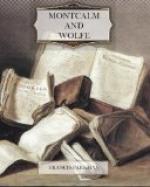On the morning after the massacre the Indians decamped in a body and set out for Montreal, carrying with them their plunder and some two hundred prisoners, who, it is said, could not be got out of their hands. The soldiers were set to the work of demolishing the English fort; and the task occupied several days. The barracks were torn down, and the huge pine-logs of the rampart thrown into a heap. The dead bodies that filled the casemates were added to the mass, and fire was set to the whole. The mighty funeral pyre blazed all night. Then, on the sixteenth, the army reimbarked. The din of ten thousand combatants, the rage, the terror, the agony, were gone; and no living thing was left but the wolves that gathered from the mountains to feast upon the dead.[526]
[Footnote 526: The foregoing chapter rests largely on evidence never before brought to light, including the minute Journal of Bougainville,—document which can hardly be commended too much,—the correspondence of Webb, a letter of Colonel Frye, written just after the massacre, and a journal of the siege, sent by him to Governor Pownall as his official report. Extracts from these, as well as from the affidavit of Dr. Whitworth, which is also new evidence, are given in Appendix F.
The Diary of Malartic and the correspondence of Montcalm, Levis, Vaudreuil, and Bigot, also throw light on the campaign, as well as numerous reports of the siege, official and semi-official. The long letter of the Jesuit Roubaud, printed anonymously in the Lettres Edifiantes et Curieuses, gives a remarkably vivid account of what he saw. He was an intelligent person, who may be trusted where he has no motive for lying. Curious particulars about him will be found in a paper called, The deplorable Case of Mr. Roubaud, printed in the Historical Magazine, Second Series, VIII. 282. Compare Verreau, Report on Canadian Archives, 1874.
Impressions of the massacre at Fort William Henry have hitherto been derived chiefly from the narrative of Captain Jonathan Carver, in his Travels. He has discredited himself by his exaggeration of the number killed; but his account of what he himself saw tallies with that of the other witnesses. He is outdone in exaggeration by an anonymous French writer of the time, who seems rather pleased at the occurrence, and affirms that all the English were killed except seven hundred, these last being captured, so that none escaped (Nouvelles du Canada envoyees de Montreal, Aout, 1757). Carver puts killed and captured together at fifteen hundred. Vaudreuil, who always makes light of Indian barbarities, goes to the other extreme, and avers that no more than five or six were killed. Levis and Roubaud, who saw everything, and were certain not to exaggerate the number, give the most trustworthy evidence on this point. The capitulation, having been broken by the allies of France, was declared void by the British Government.




